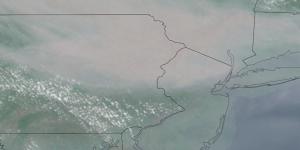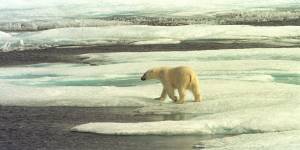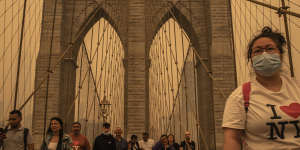During the black summer of 2019-20,our own city skylines were clouded in smoke from unprecedented bushfires and we also became all too familiar with the language of particulates,air quality and respiratory health risks.
New York City recorded the worst air quality in the world as heavy smoke from wildfires in Canada spreads across the city.
Now,three years further into the global heating crisis and only at the start of the northern summer,more temperature records have tumbled and scientists say the warning bells on climate change are at a deafening pitch. This week,meteorologists in the US said the warming El Nino climate pattern had arrived.
In Canada,fires have already burned an area 12 times the 10-year average for this time of year,with experts saying a warmer and drier spring than normal is the likely cause. Most of the smoke is from Quebec,where 150 fires are burning,and this is already the province’s worst fire season on record.
The heavy plume of wildfire smoke drifting from these fires across the eastern coast of the United States means cities in North America had the worst air quality in the world on Thursday morning,according to the US Environmental Protection Agency’s Air Quality Index.

This satellite image taken on Wednesday shows smoke from Canadian wildfires drifting across parts of New York,New Jersey and Pennsylvania.CSU/CIRA& NOAA via AP
Many parts of Asia have experienced heatwaves. This week,extreme hot weather and humidity beset southern and eastern regions of China and the power grids groaned under the strain of air conditioners in populous cities like Shenzhen and Shanghai.
Temperatures across the country reached or exceeded their records for the month of May,China’s National Climate Centre said.
In Siberia,among the regions with the strongest warming worldwide,temperature records were also broken this week,including in the cities of Baevo,which reached 39.6 degrees and Barnaul,which hit 38.5 degrees,.
And this warming is not limited to Asia. In Puerto Rico,on Tuesday the capital San Juan set a record high temperature of 35 degrees,surpassing the previous mark of 33.8 degrees.

A polar bear on the Arctic sea ice off Alaska. The Western Arctic is one of the fastest warming regions in the world.Greenpeace
The impact of climate change on natural weather variations is starkly apparent,said the University of Melbourne’s Emeritus Professor David Karoly,who is also a councillor with the Climate Council.
“Natural weather variations are now on steroids and these steroids are human-caused climate change,” said Karoly.
“Climate change makes the impact of dry events and heatwaves much more serious and the frequency and intensity of bushfires more common.”
This week also brought the news that it is already too late to preserve the sea ice during the Arctic summer,with new research from the University of Hamburg showing that even if greenhouse gas emissions are sharply reduced,the Arctic region will be ice-free by September in the decades to come.
If emissions continue to rise,or even decline slowly,the research found,the first ice-free Arctic summer could be in the 2030s. This is decades earlier than previous projections and expected to trigger more extreme weather across the northern hemisphere.
In Australia,the Bureau of Meteorology has climate pattern occurring to 70 per cent,which would bring warmer and dryer conditions this year.
In the US,which employs different standards,government meteorologists from the National Oceanic and Atmospheric Administration say the El Nino climate pattern has already arrived,and is expected to get stronger over winter.
Karoly said El Nino is associated with increases of two to three-tenths of a degree in global mean temperatures – with this increase reflected in Australia.
While the last three years of cooler and wetter La Nina conditions have suppressed the rate of temperature increase,we are likely to get record new high temperatures in Australia either this summer or the following one,he said.
“We urgently need to reduce human-caused emissions of greenhouse gases in Australia and overseas because the problems are going to get even worse,” Karoly said. “We must act.”
“Australia already has the technology and the solutions here. We are blessed with sunshine,land area and wind.
“Let’s sell renewable energy across South East Asia and become a renewable energy superpower.”

People cross the Brooklyn Bridge amid a dense haze from wildfire smoke in New York.Dave Sanders/The New York Times.
With Reuters
A guide to the environment,what’s happening to it,what’s being done about it and what it means for the future..